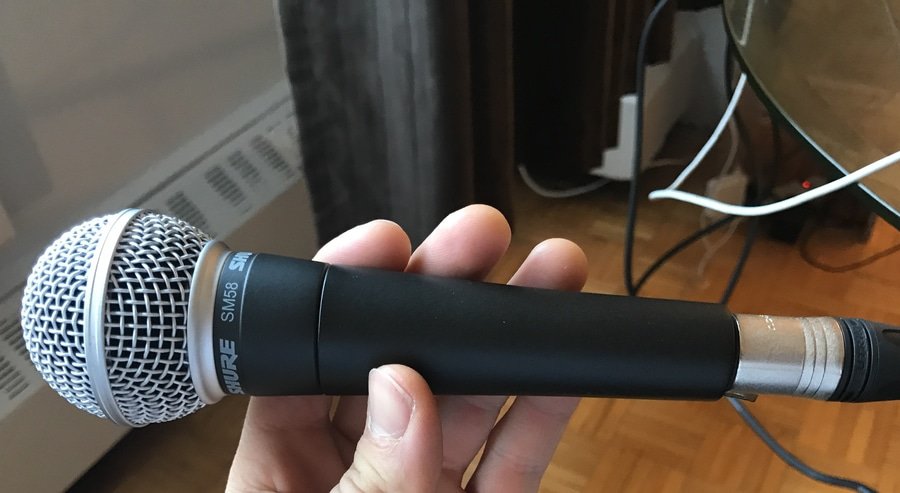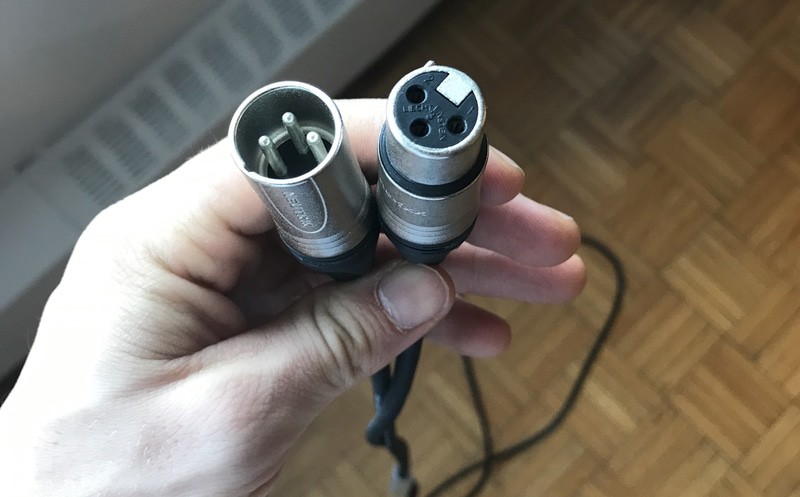As an Amazon Associate, I earn from qualifying purchases. Additionally, I earn a commission through each purchase made on Amazon, Clickbank, zZounds, Plugin Boutique, Plugin Fox, Thomann, Jam Play, and Punkademic from one of my links.
The Shure SM58 is arguably the most popular microphone for beginners in recording and live performances. If you were to walk into a music store right now and ask for a good microphone, chances are that the shop clerk would hand you a Shure SM58.
The reason is simple: the Shure SM58 is one of the best affordable and reliable microphones for people who are just getting into music production, recording, and live performances.

I even remember the church that I went to a kid had several Shure SM58 microphones. It was their mic of choice, probably because of the reason that I mentioned above – the fact it was the mic they were directed to by the person who worked at the store.
There’s a good chance that if you ever walk into a recording studio, you’ll see multiple Shure SM58 microphones. A recording set-up isn’t complete without at least one of them. Many studios will have multiple.
Truthfully, it’s not the cheapest microphone on the market, but for $100, I don’t think you can go wrong. I’m not a big fan of cheaping out when it comes to buying anything, really, so if you’re looking for a $40 microphone, then you might want to go somewhere else.
With that said, if you do want to purchase a similar microphone for a much cheaper price, you could grab the Shure SM48 (also from Amazon), which is essentially a numbed down version of the SM58. It’s a fraction of the price.
Ultimately, it’s not as good, but the option is there for those of us that are on a budget.
I would opt for purchasing the Shure SM58 that doesn’t come with the on-and-off switch, because if you’re ever singing with it during a live performance, or even just speaking with it on stage, you don’t want to accidentally turn it on and off.
What The Shure SM58 Comes With
(When you buy it off Amazon from the link I suggested at the top of the article, you’ll also get an XLR cable. If you buy it from the store, you won’t get the XLR cable).
- A microphone cable (when purchased off Amazon).
- A bag
- Instruction Manual and other documentation
- Microphone Clip
- Microphone Stand Adaptor

The Shure SM58
The SM58 is a cardioid dynamic microphone, which means that it’s unidirectional, or coming from one direction only.
This is in contrast to bi-directional and omnidirectional, which are coming from two directions and all directions, respectively. In other words, a cardioid microphone only picks up on the sounds coming from one side of the microphone.
You can check out the image below to see what I’m talking about:

The idea behind the cardioid pattern is that it makes it a better option for isolating particular sounds over others.
For instance, if you’ve recorded a YouTube video and you’re speaking into the microphone while also typing at the same time, you don’t have to worry so much about the mic picking up on extraneous noises, in this case, the sound of your fingers hitting the keys.
Due to its construction, the Shure SM58 is a great microphone for a number of purposes, including speaking, singing, and recording instruments.
The microphone is concealed with a steel mesh cage, making it so that if you drop the Shure SM58, you don’t have to worry so much about it breaking, in contrast to a condenser microphone, which you may have to worry about a bit more.
Build Quality
The Shure SM58 is a very well-built microphone, due to its steel construction. If you’ve ever read my review of the iRig HD 2, you’ll know that plastic is a pet peeve of mine.
There’s something about a plastic product that just screams low-quality, but thankfully, the Shure SM58 doesn’t have this problem. There are all kinds of YouTube videos and tutorials online which show how sturdy the SM58 is, including some clips where it shows trucks running over it and whatnot.
Frankly, I find that a bit unbelievable (and also gimmicky), but the point has been made. The Shure SM58 is a reliably constructed microphone that’s going to last you through the ages on account of its insane durability.
The body is made out of metal as is the mesh protecting the actual microphone. There is also some foam on the inside to protect it from bouncing around.
The durability of the microphone is what makes it such a popular option for live performances.
For instance, if you ever go to a karaoke night at a bar, chances are, you’ll notice that they’re using a Shure SM58 because they can take a beating from the drunk patrons who drop it on the ground repeatedly and do all kinds of nastiness to it.
How It Sounds
The SM58 is known for its emphasis on some of the mid-range sounds and the minimization of bass frequencies. This makes it great for back-up and lead vocals. Just another reason why many people around the world use it on a regular basis. Paired with Singorama from their site (the next best thing to an actual vocal coach), the SM58 is a great start to becoming a singer.
While it does have somewhat of a bass roll-off, the minimization of the bass frequencies isn’t so intense that it’s annoying or noticeable in any way. It just sounds as it should. The spherical filter within the mic reduces undesired sounds and effects, such as the “pop” sound and wind sounds. The whole idea behind a cardioid pattern is that it’s meant to emphasize certain sounds over others.
The effect of this is the emphasis of the desired sounds rather than background noises and other sounds. Moreover, there is what’s called a pneumatic shock-mount system which is supposed to minimize the noise when walking around with it.
This is also one of the reasons why Shure SM58 is such a popular option.In other words, due to the shock mount system, if you’re up on stage with it, you can easily pass it around to person-to-person and you don’t have to worry about it making all kinds of crazy noises.
Specifications of the Shure SM58
Frequency Range: 50Hz to 15,000 Hz
Weight: 298 Grams (10.5 Ounces)
Impedance: 150 ohms (300 ohms in reality) – Low Impedance.
Sensitivity: -54.5 dBV/Pa (1.85 mV) at 1,000Hz Open Circuit Voltage
It also comes with a two-year warranty afforded directly from the manufacturer. So if something is wrong with the mic, you just have to send it back to them and they’ll likely mail you a brand new microphone.
Cons of the Shure SM58
The number one con of using this microphone is the fact that it’s not the most sensitive. In other words, you’ll have to use your audio interface’s gain to drive up the power of the signal so you can hear everything (more on audio interfaces in my guide).
Another thing worth mentioning is that due to the cardioid pattern of the mic, you have to be right on top of it in order for it to sound the best. I would argue that the Shure SM58 is not the best for recording, it’s more for live performances. However, with all that said, it’s still going to work just fine for recording in your home studio.
While the Shure SM58 is not the greatest mic out there in the world, it is one of the most durable and reliable, which is the reason why it’s so popular.
How To Set Up The Shure SM58
It’s important that you have an XLR cable to hook this into your audio interface. So either buy one from the store or use the Amazon link I listed above at the beginning of the article.

Hooking up the Shure SM58 is pretty easy. I grabbed all of my equipment and set it on my bed so you can see exactly how it’s done without all of the cables making everything look convoluted.
- Plug your multi-port adaptor into your computer (here’s the laptop from Amazon I recommend).
- Use the USB to Firewire cable and run it from the adaptor into the audio interface
- Grab your XLR cable and plug it into the audio interface input and run it into the microphone jack.

Other Things To Consider
As I’ve mentioned already in the article, you want to make sure that you sing or speak directly into it due to the cardioid pattern. The sweet spot on the microphone is right on top of the microphone, which is going to emphasize warmth and clarity.
Also, there is a lot of talk about the Beta version of this microphone, which is supposed to be the improved version of the same unit, however, a lot of people say it’s much worse and not worth the money.
Due to the mic’s popularity, there are also quite a few counterfeit versions of it online, so there are definitely some things to watch out for.
For example, there doesn’t exist the SM58SK version, which is a common counterfeit version of the mic seen online.
The pop filters are made out of aluminum, and not plastic, like some of the fake mics.
Chances are if it comes with the price tag of $50-$60, it’s likely a counterfeit version.
There is no “caution” label on the original microphone either.
I would opt for purchasing it directly from your local store, or on Amazon from one of the sellers who have thousands of reviews. The link I suggested above is one of them.
Typically, I like to have the pre-amp gain on the audio interface set to about 7, which is quite high, but this mic needs the power.
YouTube Video Review
Conclusion
All-in-all, you’re not going to go wrong with the Shure SM58 when it comes to purchasing your first microphone. It’s going to pick up on what you need it to and it’s going to last you a long time. There’s a reason why it has become an industry standard.

 Written By :
Written By :